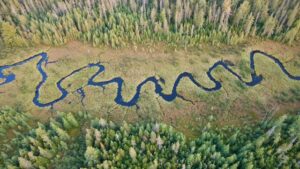How can you create an environment in your team at work where you maximise the chance everyone one pulls in the same direction?
One of the tools that was a go-to for me in managing projects in Shell was Creative Tension. The fundamental concept here is one popularised by management consultant Robert Fritz. He argued that a deliberate focus on understanding where we want to be in the future, coupled with really testing if we actually know where we are today, creates a specific organisational tension that makes it easier for every individual in the organisation to ensure their day-to-day decisions support moving towards that future vision. Without that clarity of the two end points, future and now, there’s a much higher risk that the noise in those day-to-day decisions is destructive or at best neutral rather than contributing.
The sketch I draw on white boards to illustrate the concept looks like this:

On the right, a crystallised shared vision, coupled with a clarified and tested current reality, creates a natural flow from one to the other increasing the chance that decisions, symbolised by the arrows, are taken in a way that aligns and moves the organisation towards it’s target. On the left the vision is woolly and the current reality most likely unclear, different for different people, guided by their own experiences of the situation. Decisions are rather random, often good or neutral but sometimes directly counter to the objective.
For those of a more geological bent, as many of my colleagues were, I compared the two situations to different river slopes:


A poorly defined vision/current reality combination is like a meandering river setting (first photo). The limited elevation difference between the upstream and downstream on a river plain doesn’t generate enough energy to direct the water, and as a consequence the river meanders. By contrast where the elevation difference is greater, for instance in a braided river setting on a mountain side (second photo), the potential energy drives a faster, more direct flow. Think of those day-to-day decisions like tadpoles dropped into the water – in one setting they can swim in any direction, in the other they are carried by the current towards the destination even if they try to swim upstream. The flow of the river is the analogue for the creative tension created by clarity on both the desired vision of the future, and the common understanding of the current reality.
Note that word “common” – both vision and current reality need to be debated, it doesn’t really work if it’s just one individual’s personal vision. Some dedicated time asking questions like these can really start to firm up both elements:
- Where do we want to be in X years?
- What does success actually look like and feel like then?
- How can we articulate the vision such that a new team member, or manager, will “get it”?
- What different elements need to be in place to deliver that future?
- What do those elements look like today?
- Do we know enough about where we are today, or do we need to go out and check?
- Is the view of today the same in different stakeholder groups?
- etc…etc…
I like to build this discussion into the fabric of opportunity framing sessions (see a future blog entry for more on those) but even as a small team you can make progress simply by spending some dedicated time on each in turn.
Key Message: Spending time as a team to deepen 1) the common understanding of where you want to be in the future, and 2) on truly understanding where you are today, generates a creative tension that will markedly improve the likelihood of achieving your objectives, through better alignment of decisions along the way.
For those interested in more detail on the concept, and how it might apply in organisations, here’s the books I first saw them in:
” The Path of Least Resistance: Learning to Become the Creative Force in Your Own Life”, Robert Fritz, Ballantine Books, 1989
“Corporate Tides: The Inescapable Laws of Organizational Structure”, Robert Fritz, Berrett Koehler Publishers, 1996
